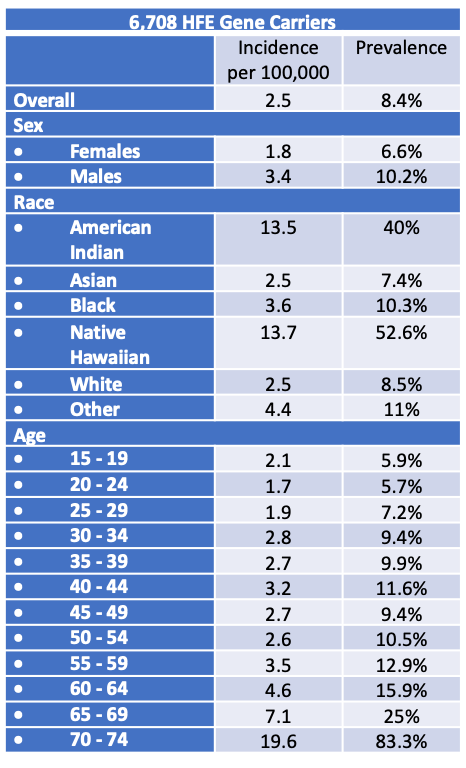Tuesday Poster Session
Category: Liver
P4693 - Incidence and Prevalence of Cirrhosis in Hemochromatosis Gene Carriers: A National Analysis
Tuesday, October 29, 2024
10:30 AM - 4:00 PM ET
Location: Exhibit Hall E

Has Audio

Tiana Dodd, DO
Charleston Area Medical Center
Charleston, WV
Presenting Author(s)
Mark Ayoub, MD1, Jessica Amos, DO2, Tiana Dodd, DO3, Shannon Wyszomierski, MS2, Witt Durden, DO2
1West Virginia University - Charleston Area Medical Center, Charleston, WV; 2WVU-CAMC, Charleston, WV; 3Charleston Area Medical Center, Charleston, WV
Introduction: Hereditary hemochromatosis (HHC) is highly associated with liver cirrhosis and is most commonly due to pathogenic variants (C282Y and H63D) in the HFE gene. Being a heterozygous carrier of HFE variants is generally considered benign, but clinical observations have raised the question, “Could heterozygosity be an independent risk factor for developing cirrhosis?” We examined the incidence and prevalence of cirrhosis in carriers of HFE variants without other high-risk factors.
Methods: We queried the Global Collaborative TriNetX Research Network, which includes records from 118 healthcare organizations. Patients without HHC but who carry any of the following HFE variants were identified: p.His63Asp, o.Ser65Cys, or g.Cys282Tyr. We excluded patients with viral hepatitis, primary sclerosing cholangitis, primary biliary cirrhosis, α-1 antitrypsin deficiency, Wilson’s disease, non-alcoholic steatohepatitis, alcohol use disorder, autoimmune hepatitis, metabolic syndrome, diabetes mellitus or hemochromatosis. We identified 6708 patients, 1/1/2000 – 3/13/2024, who matched our criteria, analyzed the incidence and prevalence of cirrhosis in these patients, and stratified based on sex, age, and race.
Results: The overall incidence rate of cirrhosis in HFE variant carriers was 2.5 per 100 000 patients. The incidence rate of cirrhosis was 1.8 per 100 000 in female carriers and 3.4 per 100 000 in male carriers. The incidence rate per 100 000 was highest in American Indian (13.5) and Native Hawaiian (13.5) patients and was lower in White (2.5), Black (3.6), and Asian (2.5) patients. By age, incidence rates per 100 000 patients were 70-74 years (19.6), 65-69 (7.1), 60-64 (4.6), 55-59 (3.5), and 40-44 years (3.2).
The overall prevalence of cirrhosis in HFE variant carriers was 8.4% (n=561), 6.6% in female carriers (n=227), and 10.2% in male carriers (n=334). The prevalence of cirrhosis by race was Native Hawaiian, 52.6%; American Indian, 40%; White, 8.5%; Black 10.3%; and Asian, 7.4%. By age, the prevalence was highest in 70-74-year-olds (83.3%) and was lower in other age groups—65-69 (25%), 60-64 (15.9%), 55-59 (12.9%), and 40-44 (11.6%).
Discussion: The incidence and prevalence of cirrhosis in HFE variant carriers without other risk factors may support carrier status as an independent risk factor for cirrhosis and should prompt further study. Detecting these variants in healthy individuals may allow them to better control modifiable risk factors for cirrhosis.

Disclosures:
Mark Ayoub, MD1, Jessica Amos, DO2, Tiana Dodd, DO3, Shannon Wyszomierski, MS2, Witt Durden, DO2. P4693 - Incidence and Prevalence of Cirrhosis in Hemochromatosis Gene Carriers: A National Analysis, ACG 2024 Annual Scientific Meeting Abstracts. Philadelphia, PA: American College of Gastroenterology.
1West Virginia University - Charleston Area Medical Center, Charleston, WV; 2WVU-CAMC, Charleston, WV; 3Charleston Area Medical Center, Charleston, WV
Introduction: Hereditary hemochromatosis (HHC) is highly associated with liver cirrhosis and is most commonly due to pathogenic variants (C282Y and H63D) in the HFE gene. Being a heterozygous carrier of HFE variants is generally considered benign, but clinical observations have raised the question, “Could heterozygosity be an independent risk factor for developing cirrhosis?” We examined the incidence and prevalence of cirrhosis in carriers of HFE variants without other high-risk factors.
Methods: We queried the Global Collaborative TriNetX Research Network, which includes records from 118 healthcare organizations. Patients without HHC but who carry any of the following HFE variants were identified: p.His63Asp, o.Ser65Cys, or g.Cys282Tyr. We excluded patients with viral hepatitis, primary sclerosing cholangitis, primary biliary cirrhosis, α-1 antitrypsin deficiency, Wilson’s disease, non-alcoholic steatohepatitis, alcohol use disorder, autoimmune hepatitis, metabolic syndrome, diabetes mellitus or hemochromatosis. We identified 6708 patients, 1/1/2000 – 3/13/2024, who matched our criteria, analyzed the incidence and prevalence of cirrhosis in these patients, and stratified based on sex, age, and race.
Results: The overall incidence rate of cirrhosis in HFE variant carriers was 2.5 per 100 000 patients. The incidence rate of cirrhosis was 1.8 per 100 000 in female carriers and 3.4 per 100 000 in male carriers. The incidence rate per 100 000 was highest in American Indian (13.5) and Native Hawaiian (13.5) patients and was lower in White (2.5), Black (3.6), and Asian (2.5) patients. By age, incidence rates per 100 000 patients were 70-74 years (19.6), 65-69 (7.1), 60-64 (4.6), 55-59 (3.5), and 40-44 years (3.2).
The overall prevalence of cirrhosis in HFE variant carriers was 8.4% (n=561), 6.6% in female carriers (n=227), and 10.2% in male carriers (n=334). The prevalence of cirrhosis by race was Native Hawaiian, 52.6%; American Indian, 40%; White, 8.5%; Black 10.3%; and Asian, 7.4%. By age, the prevalence was highest in 70-74-year-olds (83.3%) and was lower in other age groups—65-69 (25%), 60-64 (15.9%), 55-59 (12.9%), and 40-44 (11.6%).
Discussion: The incidence and prevalence of cirrhosis in HFE variant carriers without other risk factors may support carrier status as an independent risk factor for cirrhosis and should prompt further study. Detecting these variants in healthy individuals may allow them to better control modifiable risk factors for cirrhosis.

Figure: Summary of Results
Disclosures:
Mark Ayoub indicated no relevant financial relationships.
Jessica Amos indicated no relevant financial relationships.
Tiana Dodd indicated no relevant financial relationships.
Shannon Wyszomierski indicated no relevant financial relationships.
Witt Durden indicated no relevant financial relationships.
Mark Ayoub, MD1, Jessica Amos, DO2, Tiana Dodd, DO3, Shannon Wyszomierski, MS2, Witt Durden, DO2. P4693 - Incidence and Prevalence of Cirrhosis in Hemochromatosis Gene Carriers: A National Analysis, ACG 2024 Annual Scientific Meeting Abstracts. Philadelphia, PA: American College of Gastroenterology.
